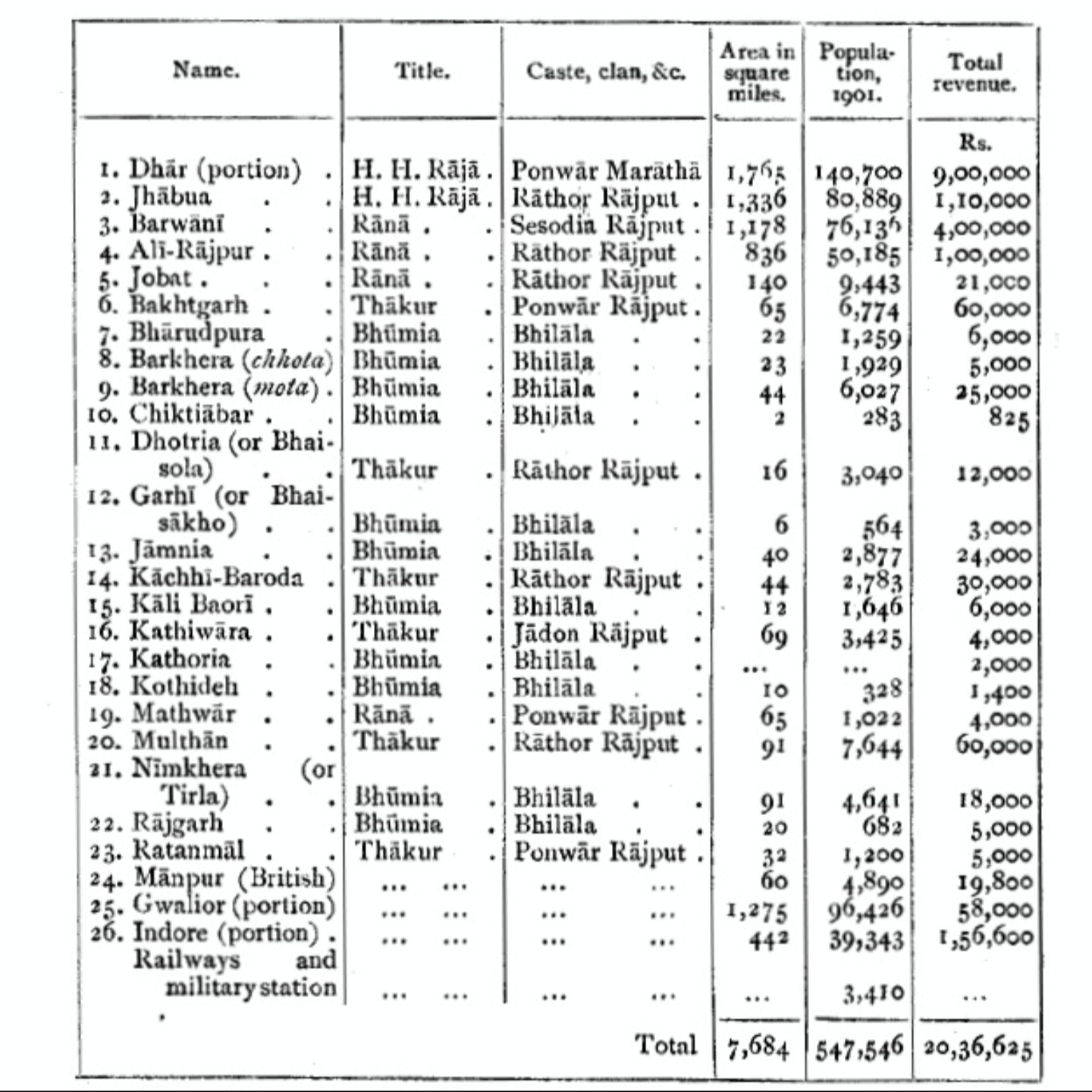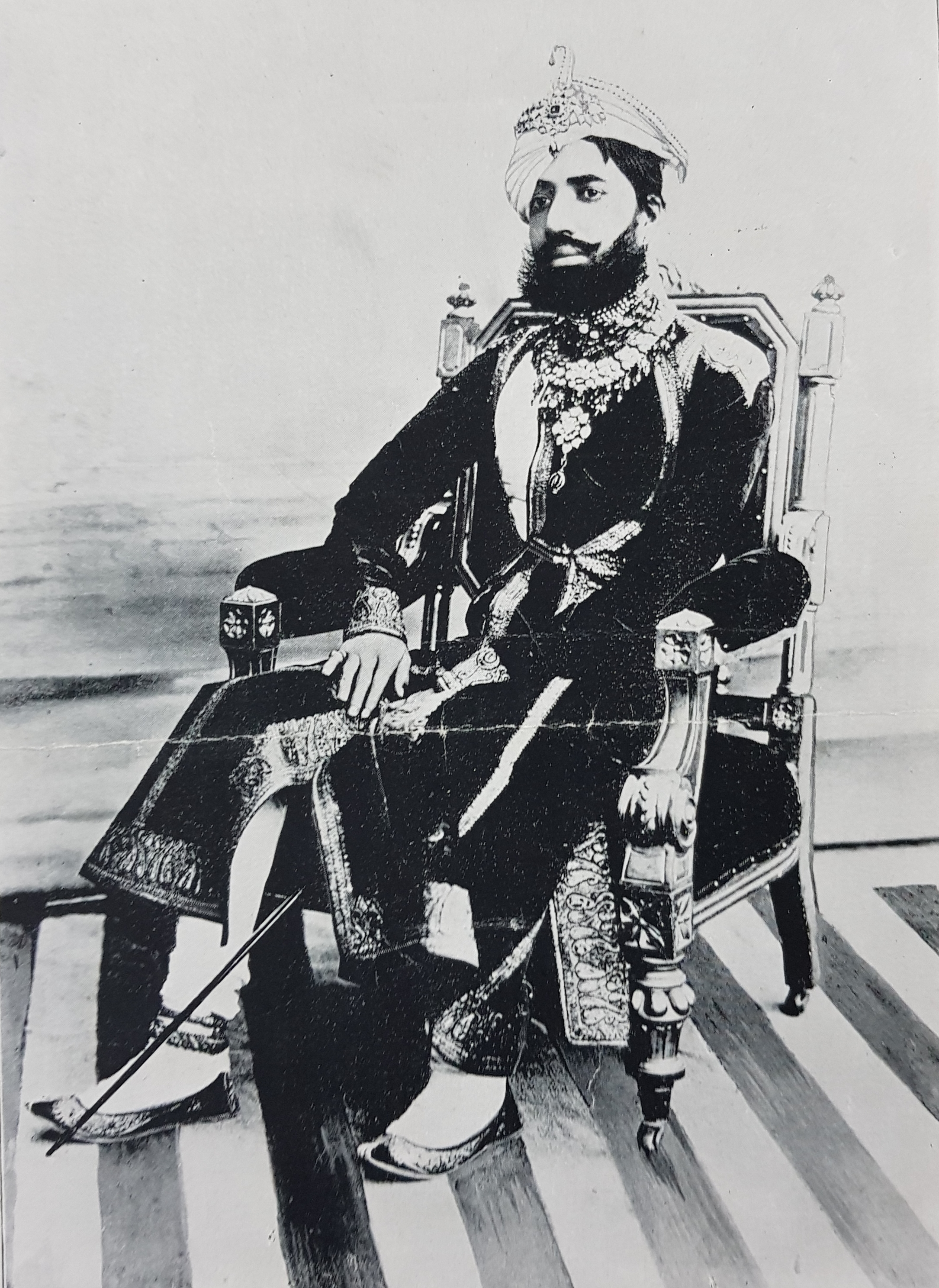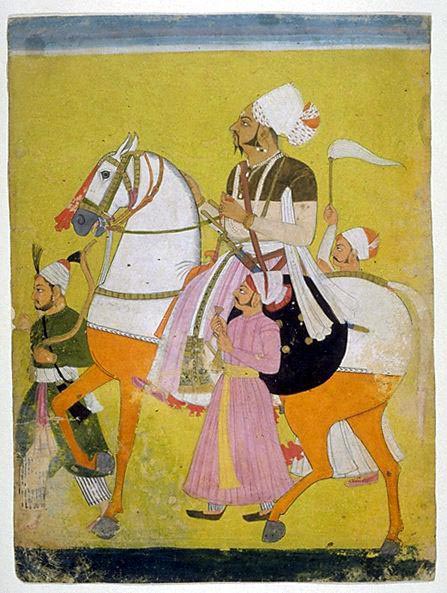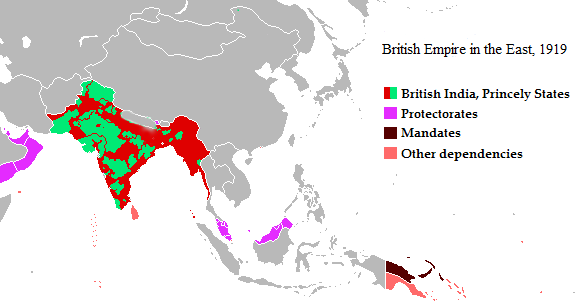|
Malwa Agency
Malwa Agency was an administrative section of India's Central India Agency. The headquarters of the political agent was at Mandsaur (Mandasor) / Neemuch (Nimach). The other chief towns of the region were : Ratlam and Jaora. History The Malwa Agency was formed in 1895 out of princely states in the Northern Malwa region formerly under the authority of the British agent for Indore and the abolition of the Western Malwa Agency which had been a sub-agency of the Central India Agency since 1854.Sir William Wilson Hunter. ''The Imperial Gazetteer of India''. London: Trübner & co., 1885. The Dewas States ( Dewas Senior & Dewas Junior) were added to Malwa Agency in 1907. In 1925 Malwa Agency was amalgamated with Bhopawar Agency to form the Malwa and Bhopawar Agency, renamed the Malwa and Southern States Agency in 1927. The Dewas States were transferred to Bhopal Agency in 1931, and in 1934 the agency was once again renamed Malwa Agency. After Indian independence in 1947, the rulers ... [...More Info...] [...Related Items...] OR: [Wikipedia] [Google] [Baidu] |
British India
The provinces of India, earlier presidencies of British India and still earlier, presidency towns, were the administrative divisions of British governance on the Indian subcontinent. Collectively, they have been called British India. In one form or another, they existed between 1612 and 1947, conventionally divided into three historical periods: *Between 1612 and 1757 the East India Company set up Factory (trading post), factories (trading posts) in several locations, mostly in coastal India, with the consent of the Mughal emperors, Maratha Empire or local rulers. Its rivals were the merchant trading companies of Portugal, Denmark, the Netherlands, and France. By the mid-18th century, three ''presidency towns'': Madras, Bombay and Calcutta, had grown in size. *During the period of Company rule in India (1757–1858), the company gradually acquired sovereignty over large parts of India, now called "presidencies". However, it also increasingly came under British government over ... [...More Info...] [...Related Items...] OR: [Wikipedia] [Google] [Baidu] |
Bhopal Agency
The Bhopal Agency was a section of British India's colonial Central India Agency, a British political unit which managed the relations of the British with a number of autonomous princely states existing outside British India.Great Britain India Office. ''The Imperial Gazetteer of India''. Oxford: Clarendon Press, 1908. History The Agency was formed in 1818 at the conclusion of the Third Anglo-Maratha War, and covered the princely states of Bhopal (largest and eponymous), Khilchipur, Kurwai, Narsingarh, Muhammadgarh, Pathari and Rajgarh surrounding Bhopal, as well as the districts of Bhilsa and Isagarh, which belonged to the Gwalior State and also the district of Sironj, which belonged to Tonk State in Rajputana. The head of the Agency was appointed by the British Governor-General of India. In 1854 the Bhopal Agency became part of the newly created Central India Agency. In 1895 the Gwalior districts of Bhilsa and Isagarh were transferred from Bhopal Agency to Gwalior Resi ... [...More Info...] [...Related Items...] OR: [Wikipedia] [Google] [Baidu] |
Indore State
Indore State, also known as Holkar State, was a kingdom in India. Its rulers belonged to the Holkar dynasty. After 1857, Indore became a 19-gun salute Maratha princely state (a rare high rank) under the British Raj. Indore state was located in the present-day Indian state of Madhya Pradesh. The capital of the state was the city of Indore. The state had an area of 24,605 km2 and a population of 1,325,089 in 1931. Other important towns besides Indore were Rampura, Khargone, Maheshwar, Mehidpur, Barwaha, and Bhanpura; there were a total of 3,368 villages. History By 1720, the headquarters of the local ''pargana'' (an Indian local administrative unit) was transferred from Kampel to Indore due to the increasing commercial activity in the city. On 18 May 1724, the ''Nizam'' accepted the rights of the Maratha Peshwa Baji Rao I to collect ''chauth'' (taxes) from the area. In 1733, the ''Peshwa'' assumed full control of Malwa and appointed his commander Malhar Rao Ho ... [...More Info...] [...Related Items...] OR: [Wikipedia] [Google] [Baidu] |
Gwalior State
Gwalior state was a semi-autonomous Maratha state. It was centred in modern-day Madhya Pradesh, arising due to the rise of the Maratha Empire and fragmentation of the Mughal Empire. It was ruled by the House of Scindia (anglicized from Shinde), a Hindu Maratha dynasty, and was entitled to a 21-gun salute when it became a princely state of the India. The state took its name from the old town of Gwalior, which, although not its first capital, was an important place because of its strategic location and the strength of its fort; it became later its capital, after Daulat Rao Sindhia built its palace in the village of Lashkar, near the fort. The state was founded in the early 18th century by Ranoji Sindhia, as part of the Maratha Confederacy. The administration of Ujjain was assigned by Peshwa Bajirao I to his faithful commander Ranoji Shinde and his Sarsenapati was Yasaji Rambhaji (Rege). The Diwan of Ranoji Shinde (Scindia) was Ramchandra Baba Shenvi who was very wealthy; he re- ... [...More Info...] [...Related Items...] OR: [Wikipedia] [Google] [Baidu] |
Panth-Piploda
Panth-Piploda was a province of British India. It is located in present-day Ratlam district of Madhya Pradesh state of central India. Panth-Piploda was British India's smallest province, with an area of , and a population of 5267 (male 2666, female 2601) (1941 census). It was located in the Malwa region, and consisted of several separate enclaves, bounded by the princely states of Gwalior, Jaora, and Dewas. The province was governed by a chief commissioner appointed by the Governor-General of India. History In 1935 Panth Piploda was separated from Bombay. Panth-Piploda was a small tract of territory comprising only 10½ villages, which were held by five different ''thakur''s. In 1765, the Peshwa of the Maratha Empire assigned the revenues from the villages to the family of Sambhaji Attaji, a Deshastha Brahmin. This ruling family was later known as the family of the Khandekar Pandits. The arrangement made by the Peshwa was respected by the British when they took over Panth Pip ... [...More Info...] [...Related Items...] OR: [Wikipedia] [Google] [Baidu] |
Piploda State
Piploda State was an estate in India at the time of the British Raj. It belonged to the Malwa Agency, part of the Central India Agency. The state had an area of 155 km2. History The Thakurs of Piploda were Dodiya Rajputs from the Kathiawar region, one of the ancestors called Kaluji migrated to Malwa and captured the fort of Sabalgarh in 1285. The Sixth son of Kaluji who was called Shardul Singh extended his domains and founded the village of Piploda. During the rise of the Marathas in Malwa, Piploda was reduced to a great extent and the thakur was forced to become a vassal of Amir Khan Pindari. Piploda later benefited from the treaty of Mandsore, in which Jaora was confirmed as a princely state by the British. The Thakur of Piploda was allowed to rule in his estate on the condition that he pays Rs.28,000 as tribute to the Jaora nawab. During the great Indian mutiny, the Thakur of Piploda helped the British authorities by sending his army to Mandsaur. The estate had 28 villa ... [...More Info...] [...Related Items...] OR: [Wikipedia] [Google] [Baidu] |
Sitamau State
Sitamau State was a princely state of the British Raj before 1947. Its capital was in Sitamau town, Mandsaur district, Madhya Pradesh. The total area of the state was 350 square miles. The average revenue of the state was Rs.130,000. History Ratan Singh Rathore was killed in the battle of Dharmat, after which his descendants continued to rule Ratlam. During Raja Keshodas's reign some soldiers of the Raja killed the Jaziya tax collectors due to which the Mughals completely annexed Ratlam. Keshodas stuck to imperial service during this time and on 3rd September 1699, he was made the faujdar of Nalgunda. Due to his good governance, Aurangzeb later granted Keshodas the Pargana of Titrod from which Raja Keshodas founded Sitamau State on 31st October 1701. The State of Ratlam was restored to an uncle of Keshodas called Chattrasal in 1705. In 1714 the emperor Farrukhsiyar further added the paragana of Alot to the new state. Sitamau faced invasions after the decline of the Mughal Empir ... [...More Info...] [...Related Items...] OR: [Wikipedia] [Google] [Baidu] |
Jhabua State
Jhabua State was one of the princely states of India during the period of the British Raj. It had its capital in Jhabua town. Most of the territory of the princely state was inhabited by the Bhil people, who constituted a majority of the population. The revenue of the state in 1901 was Rs.1,10,000. History The state of Jhabua was founded by Kesho Das or Kishan Das, in 1584. He was granted the title of ''Raja'' by Mughal Emperor Akbar as a reward for a successful campaign in Bengal, and for punishing the Bhil Chiefs of Jhabua Labana, who had murdered the wife and daughters of the Imperial Viceroy of Gujarat. Khushal Singh was the ruler of Jhabua in 1698, he gave much of his lands to his brothers and sons and was too weak to rule his state effectively. This allowed the Marathas to actively invade Jhabua on a regular basis. Raja Shiv Singh was an infant and therefore the states administration during this time was managed by the raja's mother and the nobles. The Marathas under Holk ... [...More Info...] [...Related Items...] OR: [Wikipedia] [Google] [Baidu] |
Sailana State
Sailana State was an 11 gun salute princely state in India, part of the Malwa Agency of Central India during the British Raj. The state enjoyed an estimated revenue of Rs.5,00,000. History Sailana State was founded by Raja Jai Singh, great-grandson of Maharaja Ratan Singh, founder of Ratlam State. It is a branch of the Rathore house. In 1716 Jai singh took revenge against his uncle for the murder of his father, he killed him in a pitched battle at sagode and secured Ratlam for his elder brother. The two brothers then divided the state between themselves. Jai singh's capital was initially at Raoti. He built Sailana as his new capital in 1736. During this period the Maratha influence in central India had been growing and several states had been annexed or forced to pay heavy tributes to the Peshwa. However Jai singh had the wisdom to form alliances with the Maratha officials, he helped the Peshwa agent Ambaji Pant Trimbak Purandare to collect tribute in Malwa and used the situa ... [...More Info...] [...Related Items...] OR: [Wikipedia] [Google] [Baidu] |
Jaora State
Jaora State was a 13 gun-salute princely state of the British Raj. It was part of the Malwa Agency. The total area of the princely state, with the dependencies of Piploda and Panth-Piploda, was . Jaora state was divided into four tehsils, Jaora, Barauda, Tal, and Barkhera. The chief crops were millets, cotton, maize and opium. The revenue of the state was Rs.8,50,000 in 1901. History Jaora State was established by the British and was handed over to Abdul Ghafur Muhammad Khan in 1818, so that he can maintain an army of 1,000 soldiers for the East India Company. 'Abdu'l Ghafur Muhammad Khan was a cavalry officer serving the Pashtun leader Muhammad Amir Khan. He later served the Holkar maharaja of Indore State. The state was confirmed by the British government in 1818 by the Treaty of Mandsaur. The Nawab of Jaora was confirmed the possession of Jaora, Sanjit, Tal, Malhargarh, Bharauda and the right to levy tribute from Piploda. The Nawab was expected to serve the British by ... [...More Info...] [...Related Items...] OR: [Wikipedia] [Google] [Baidu] |
Ratlam State
Ratlam State was a 13 gun salute (15 local) princely state in India, part of the Malwa Agency of Central India during the British Raj. The state's capital was Ratlam town in modern Ratlam district of Madhya Pradesh. Ratlam State was originally a prosperous kingdom, its parganas included Dharad (Ratlam), Raoti, Dhamnod, Badnawar, Dagparawa, Alot, Titrod, Kotri, Gadgucha, Agar, Nahargarh, Kanar, Bhilara and Ramgharia yielding a revenue of Rs.53,00,000 in the 17th century. Maharaja Ratan Singh Rathore of Ratlam supported Dara Shukoh during the Mughal succession war. However Dara Shukoh lost and Ratan Singh was killed in battle. The new emperor Aurangzeb annexed Ratlam and reduced the state to a great extent. The state further lost land to the Scindias of Gwalior. During British rule in 1901 the state had an area of 1795 km2 and an estimated revenue of Rs.8,00,000. History Early history The rulers of Ratlam were originally princes and Jagirdars (nobles) of Marwar. Dalpat ... [...More Info...] [...Related Items...] OR: [Wikipedia] [Google] [Baidu] |
Salute State
A salute state was a princely state under the British Raj that had been granted a gun salute by the British Crown (as paramount ruler); i.e., the protocolary privilege for its ruler to be greeted—originally by Royal Navy ships, later also on land—with a number of cannon shots, in graduations of two salutes from three to 21, as recognition of the state's relative status. The gun-salute system of recognition was first instituted during the time of the East India Company in the late 18th century and was continued under direct Crown rule from 1858. As with the other princely states, the salute states varied greatly in size and importance. The states of Hyderabad and Jammu and Kashmir, both with a 21-gun salute, were each over 200,000 km2 in size, or slightly larger than the whole of Great Britain; in 1941, Hyderabad had a population of over 16,000,000, comparable to the population of Romania at the time, while Jammu and Kashmir had a population of slightly over 4 millio ... [...More Info...] [...Related Items...] OR: [Wikipedia] [Google] [Baidu] |

_in_Indore%2C_MP_(5102818067).jpg)





